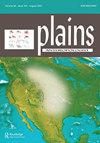People in a Sea of Grass: Archaeology’s Changing Perspective on Indigenous Plains Communities
Q2 Social Sciences
引用次数: 2
Abstract
contrary to technological analysis—have the advantage of including the entirety of flake assemblages. Analyses were also performed to understand the mixed character of the archaeological record. An impressive array of statistical analyses demonstrates significant differences in lithic assemblages from the Modena and Tempiute quarries. Consistency in results from attribute and mass analysis lends support to the arguments made here and to the complementary utilization of these techniques in lithic analysis. Chapters 6 and 7 are dedicated to the analysis of bifaces, which are abundant, especially in Modena’s case. Part of Chapter 6 discusses the continuum-versus-staged nature of the biface-reduction process, a historically relevant theme. Errett Callahan’s reduction stages within a continuum play an important role in this analysis, reflecting the influence of this approach in lithic analyses in North American archaeology. Shott’s results demonstrate some inconsistencies between some variables’ values—size, edge, and faceting—within Callahan’s stages. There are, however, consistent results between biface and flake analysis. Spatially, in the case of Modena, variation between different areas was recognized, as well as between bifaces recovered in the quarries and in spaces located farther away. Results obtained from the application of the “field processing model” supports its utilization; however, as Shott mentions, additional work is required to resolve problems of equifinality. I tend to think that in this case, an important one is modeling the effect of transport costs versus risk manufacture failure. Chapter 8 deals with different methods of estimating scales of quarrying and tool production. Results indicate that, in spite of the impressive spatial scale of the obsidian deposits, there are relatively modest rates of toolstone consumption. Quarry depletion over time could have transformed the analyzed quarries from logistically targeted places to opportunistically visited places. Chapter 9 deals with obsidian-hydration dating and allows Shott to temporally situate Modena’s peak usage. The calibrated results obtained suggest a steady rise from 11,000 BP to a peak at 4000–3000 BP, followed by a decline. These outcomes differ from the ones obtained in sites in its terrane, which suggest an older use time interval. Different reasons for this variation are suggested. Chapter 10 shows the overall archaeological distribution of both sources, which can be the product of very small populations. An important point made by Shott is that the utilization of particular terranes does not depend on source abundance, quality, and accessibility in isolation but instead becomes significant “in comparison with other sources” (p. 235). Chapter 11 summarizes questions posed and tentative answers obtained, along with questions for future research. The information included in each chapter as well as the analysis performed make this book a valuable contribution for specialists in lithic technology all over the world.草海中的人:考古学对土著平原社区的变化视角
与技术分析相反——具有包括整个薄片组合的优点。还进行了分析,以了解考古记录的混合特征。一系列令人印象深刻的统计分析表明,摩德纳和坦皮乌特采石场的石器组合存在显著差异。属性和质量分析结果的一致性支持了这里提出的论点,并支持了这些技术在石器时代分析中的互补利用。第6章和第7章专门分析了双平面,这是丰富的,尤其是在莫德纳的情况下。第6章的一部分讨论了双面还原过程的连续性与阶段性,这是一个历史相关的主题。埃雷特·卡拉汉在一个连续体中的还原阶段在这一分析中发挥了重要作用,反映了这种方法在北美考古中对石器时代分析的影响。Shott的结果表明,在卡拉汉的阶段中,一些变量的值——尺寸、边缘和表面——之间存在一些不一致。然而,在双平面和薄片分析之间存在一致的结果。在空间上,就莫德纳而言,不同区域之间的差异,以及采石场和更远空间中回收的双平面之间的差异都得到了认可。“实地处理模式”的应用结果支持了该模式的利用;然而,正如肖特所提到的,需要做更多的工作来解决公平性问题。我倾向于认为,在这种情况下,一个重要的问题是建模运输成本对制造失败风险的影响。第8章论述了估算采石和工具生产规模的不同方法。结果表明,尽管黑石矿床的空间规模令人印象深刻,但工具石的消耗率相对适中。随着时间的推移,采石场的枯竭可能会将分析的采石场从后勤目标地转变为机会主义访问地。第9章涉及黑曜石水合作用的年代测定,并允许肖特暂时定位莫德纳的峰值使用量。获得的校准结果表明,从11000 BP稳步上升到4000–3000 BP的峰值,然后下降。这些结果与在其地体中的地点获得的结果不同,后者表明使用时间间隔较长。提出了造成这种变化的不同原因。第10章显示了这两个来源的总体考古分布,这可能是非常小的人口的产物。肖特提出的一个重要观点是,特定地体的利用并不取决于来源的丰度、质量和可及性,而是“与其他来源相比”变得重要(第235页)。第11章总结了提出的问题和获得的初步答案,以及未来研究的问题。每一章所包含的信息以及所进行的分析使本书成为世界各地石器技术专家的宝贵贡献。
本文章由计算机程序翻译,如有差异,请以英文原文为准。
求助全文
约1分钟内获得全文
求助全文

 求助内容:
求助内容: 应助结果提醒方式:
应助结果提醒方式:


